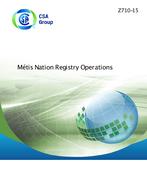Preface
This is the first edition of CSA Z710, Metis Nation Registry Operations.
Introduction
The Historic Metis Nation has declared the right of self-determination and in so declaring has provided a mechanism for the identification of its citizens/members. The National Definition of Metis, ratified by the Metis National Council General Assembly in 2002, is applied to any individual pursuing to be a citizen/member of the Metis Nation. The Metis emerged as a distinct people or nation in the historic Northwest during the course of the 18th and 19th centuries. This area is known as the “Historic Metis Nation Homeland,” which includes the three Prairie Provinces and extends into a part of Ontario, British Columbia, the Northwest Territories, and the northern United States. The Metis National Council Governing Members subsequently adopted the National Definition of Metis:
- “Metis” means a person who self-identifies as Metis, is distinct from other Aboriginal peoples, is of Historic Metis Nation Ancestry and who is accepted by the Metis Nation.
The Constitution Act, 1867, Section 91(24) provides that the federal government has the legislative jurisdiction for “Indians and lands reserved for Indians”. The Constitution Act, 1982, reads as follows:
- 35. (1) The existing aboriginal and treaty rights of the aboriginal peoples of Canada are hereby recognized and affirmed. (2) In this Act, “aboriginal peoples of Canada” includes the Indian, Inuit, and Metis peoples of Canada.
These two Acts provide for the ongoing relationship between Canada and the Aboriginal peoples. In 2003, the Supreme Court of Canada confirmed that the Metis people are a rights-bearing Aboriginal people. Its judgment in R. v. Powley stated “self-identification, ancestral connection, and community acceptance are factors which define Metis identity for the purpose of claiming Metis rights under Section 35…. The verification of a claimant’s citizenship/membership in the relevant contemporary community is crucial, since individuals are only entitled to exercise Metis aboriginal rights by virtue of their ancestral connection to and current citizenship/membership in a Metis community.” The Metis are a distinct Aboriginal people with Aboriginal rights arising from their distinct culture, way of life, and recognizable group identity separate from their Indian, Inuit, or European relations. The Supreme Court of Canada pronounced that citizenship/membership requirements must become more standardized so that legitimate constitutional rights-holders can be identified and prudent Registry requirements be employed. The term “Metis” in Section 35 of the Constitution Act, 1982, does not encompass all individuals with mixed Indian and European heritage; rather, it refers to distinctive peoples who, in addition to their mixed ancestry, developed their own customs and recognizable group identity separate from their Indian or Inuit and European forebears. The development of a more systematic method of identifying Metis rights-holders is an urgent priority. The verification of a claimant’s citizenship/membership in the contemporary Metis community is crucial, since individuals are only entitled to exercise Metis Aboriginal rights by virtue of their ancestral connection to and current citizenship/membership in a Metis community. The process of registration in a Registry must be objectively verifiable. The Metis Nation has always asserted its inherent right to determine its own citizenship/membership. The Supreme Court of Canada confirmed that Metis communities themselves have a significant role to play in the identification of the citizens/members of the Metis Nation. This Standard is designed to ensure the process of identification and registration of Metis citizens/members, pursuant to the National Definition of Metis, is efficient and objectively verifiable. This Standard aims to ensure the integrity of the processes employed by the Registry by addressing practical operational components such as security of information, privacy, quality of service, completeness and consistency of processes, and management and storage of records. This Standard supports the operation of the Registry in a consistent and fair manner based on objectively verifiable criteria.
Scope
1.1 This Standard outlines requirements and best practices for the operational elements of the Metis Nation Registry. 1.2 This Standard addresses the objectively verifiable operational elements of the Registry and does not define any test elements or evaluation criteria used by the Registry for identifying and registering citizenship/membership. The National Definition of Metis, as it exists from time to time, Powley test elements, and criteria employed by the Registry are not within the scope of this Standard. Note: Only those Individuals meeting the eligibility criteria required by the National Definition of Metis are issued a citizenship/membership card. 1.3 In this Standard, “shall” is used to express a requirement, i.e., a provision that the user is obliged to satisfy in order to comply with the standard; “should” is used to express a recommendation or that which is advised but not required; and “may” is used to express an option or that which is permissible within the limits of the Standard. Notes accompanying clauses do not include requirements or alternative requirements; the purpose of a note accompanying a clause is to separate from the text explanatory or informative material. Notes to tables and figures are considered part of the table or figure and may be written as requirements. Annexes are designated normative (mandatory) or informative (non-mandatory) to define their application.
Product Details
- Edition:
- 1st
- Published:
- 03/01/2015
- ISBN(s):
- 9781771397018
- Number of Pages:
- 19
- File Size:
- 1 file , 1.2 MB
- Product Code(s):
- 2423174, 2423859, 2423174, 2423174
